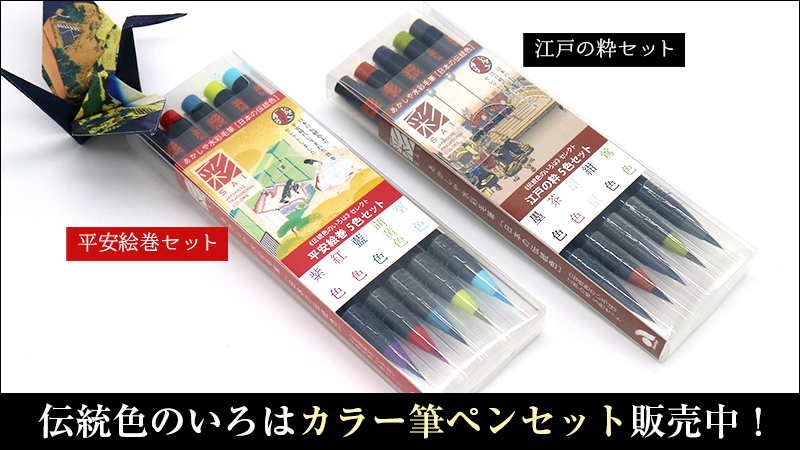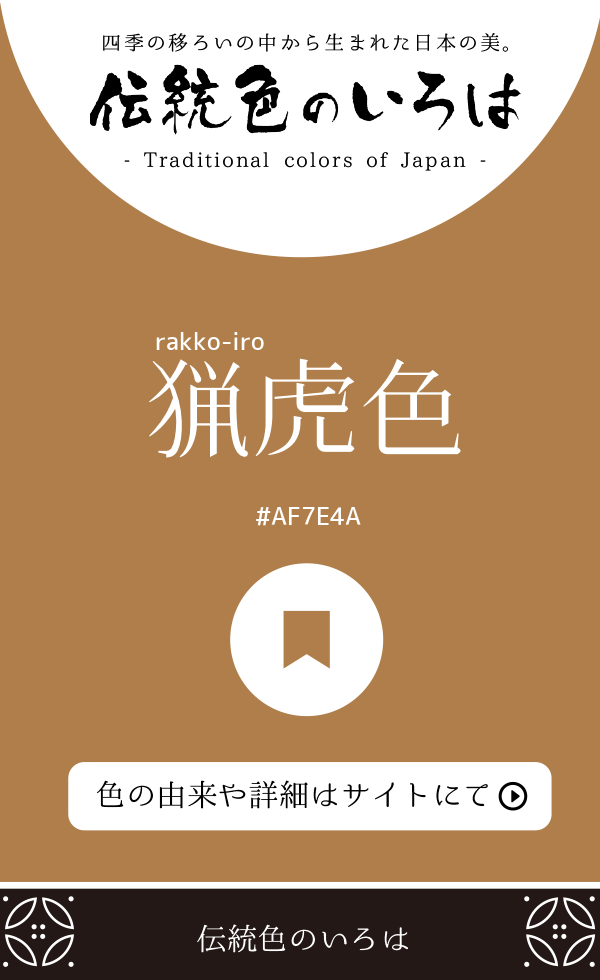| 色の名前Japan Color Name | 猟虎色(らっこいろ) |
|---|---|
| ローマ字Romanized | rakko-iro |
| RGB | R:175 G:126 B:074 |
| CMYK | C:00 M:38 Y:60 K:40 |
| Web カラーHex triplet |
色の説明
猟虎色(らっこいろ)とは、ラッコ(猟虎)の毛色のような渋い黄みがかった茶色のことです。明治期に猟虎帽 (ラッコの毛皮の帽子)が流行しており、その頃に色名として定着したものと考えられます。
日本では動物の名前に由来する色名が少なく、また現代の感覚ではラッコはそれほど身近な動物ではないので、日本の伝統色に『猟虎色 』があるのは意外に思えるかもしれませんが、実はラッコの毛皮は古くから高級品として珍重され、現代の我々が考えるよりも身近な存在でした。
たとえば、延徳二年(一四九◯年)の文献「古文真宝彦龍抄 」には、「是等 はらっこの皮な者共也。」と書かれています。これは「ラッコの手ざわりの良い毛皮」から転じて、「誰にでも従順で、人の言いなりになる者たち」と比喩しているわけです。こうした比喩表現からも、当時の日本においてラッコの毛皮が広く知られていたことがうかがえます。
さらに、天文十七年(一五四八年)に編纂された百科事典の「運歩色葉集 」にも「らっこのかわ」が掲載されており、江戸時代以前から知識階級の間ではラッコが一定の認知を得ていたことが見て取れます。
続いて、天文二十年(一五五一)の『御内書要文 』によると、若狭守護の武田義統 が将軍足利義晴にラッコの革袴を献上しており、十六世紀にはラッコ皮の製品化が進み、贈答品として用いられるほど価値あるものとされていたことがわかります。
このような歴史的背景を持つラッコの体色が、猟虎帽子の流行にともない『猟虎色』として色名となったのは自然な流れでしょう。渋く落ち着いた色合いのなかに、当時の人々の暮らしや価値観、そして文明開化の広がりを反映した文化的背景を象徴する色といえるでしょう。
ラッコ(猟虎)
ラッコは、食肉目イタチ科に属する哺乳類。成体は全長約1.3m、体重25~40kg。カワウソに似た姿で、短い円筒状の尾と発達した水かきのある後肢をもち、泳ぎに適応している。
太平洋北部沿岸(アラスカ、カリフォルニア、北千島など)に生息し、海藻を体に巻いて海上で眠る習性がある。
体色は黒褐色から灰褐色まで個体差が大きい。体毛は密で光沢があり、保温性に優れる。その毛皮は非常に高価で、かつて乱獲され絶滅寸前となり、現在は国際的に保護対象となっている。
「ラッコ」の名前は、もともとアイヌ語の"rakko"に由来しており、漢字では「猟虎」「海虎」「落虎」「海獺」などと書かれた。 平安時代には「独犴」の皮が陸奥国の交易品とされており、この「独犴」がラッコを指すのではないかと言われている。なお陸奥国で獲れたのか、北海道方面から得たのかは不明である。
なお、一九五◯年発刊の「色名大辞典」には「猟虎の毛皮のごとき”濃褐色”をいう」と記されていますが、ラッコの毛色が黒褐色から灰褐色まで個体差が大きいため、『猟虎色』もまたある程度、幅をもった渋い褐色にあたるようです。
 らっこ
らっこ
-読み:らっこいろ-
関連する色の紹介
[Explanation of a color]
"Rakkoiro" (猟虎色), or "sea otter color," is a subdued yellowish-brown shade reminiscent of the fur of the sea otter (known in Japanese as "rakko" or 猟虎). This color name is believed to have become established during the Meiji period, when "rakko bō"—hats made from sea otter fur—were in vogue.
In Japan, there are relatively few traditional color names derived from animal names, and to modern sensibilities, sea otters may not seem like a familiar presence. For that reason, one might be surprised to find a traditional Japanese color named after the sea otter. However, sea otter fur has long been prized as a luxurious material, and was actually more familiar to people in the past than we might imagine today.
For example, in the Kobun Shinpō Keirinshō (古文真宝彦龍抄), a literary work dating to around 1490 (Entoku 2), there is a passage that reads:
“These are people like ‘rakko no kawa’ (sea otter fur).”
This comparison suggests that sea otter fur was known for its smooth texture and used metaphorically to describe people who were obedient or easily led. Such a metaphor indicates that sea otter fur was widely recognized in Japan at the time.
Further evidence can be found in the Unpo Irohajū (運歩色葉集), an encyclopedia compiled around 1548 (Tenbun 17), which includes the term "rakko no kawa" (sea otter skin). This implies that knowledge of sea otters had reached Japan’s educated classes even before the Edo period.
In addition, according to the Gonaisho Yōmon (御内書要文), in 1551 (Tenbun 20), Yoshimune Takeda, lord of Wakasa Province, presented a pair of sea otter-skin trousers to Shōgun Ashikaga Yoshiharu. This suggests that sea otter leather goods were being manufactured in the 16th century and were considered valuable enough to be used as gifts among the elite.
Given this historical background, it is only natural that the sea otter’s fur color would later be formalized as the color name Rakkoiro, especially during the time when rakko hats became popular. The color reflects not only a refined aesthetic but also the cultural backdrop of the Meiji era—a period marked by modernization and expanding global connections.
Rakkoiro is a calm, earthy tone. According to the Color Name Dictionary (Shikimei Daijiten, 1950), it refers to a “dark brown resembling the fur of the sea otter.” Since actual sea otter fur varies greatly—from dark brown to grayish-brown—Rakkoiro likely also encompasses a range of muted brown shades, rather than a single fixed tone.
-read: rakko-iro-
参考書籍
- 長崎盛輝『新版 日本の伝統色 その色名と色調』青幻舎 ISBN-10:4861520711
- 吉岡幸雄『日本の色辞典』紫紅社 ISBN-10:4879405493
- 内田 広由紀『定本 和の色事典』視覚デザイン研究所 ISBN-10:4881082035
注意事項
表示されている色(RGB値)は色の名前に対するおおよそものです。色名によっては広範囲の色を指す場合や文献・書籍等によっては解釈が異なる場合もありますのでご了承ください。 ご利用の環境によっては、色が適切に表示されていない場合があります。
印刷などに伝統色を利用したい場合は、DICグラフィックス株式会社から発売されている日本の伝統色シリーズがオススメです。
Pinterestでシェアする際にご利用ください。
サイト運営者からのお願い
このサイトが気に入った、役に立ったと思われた方は、Amazon・楽天で買い物をする際はぜひ下記のバナーをタップしてからお買い物をお願いいたします。
こちらからお買い物をしていただきますと、価格の1%相当のポイントがサイトに入ります。もちろんその分、高くなるようなことはありません。
いただいたポイントは今後のサイト運営のための書籍代や運営費、モチベーションにつながりますので、ご協力いただけますと嬉しいです。

 DIC 日本の伝統色 第9版
DIC 日本の伝統色 第9版



